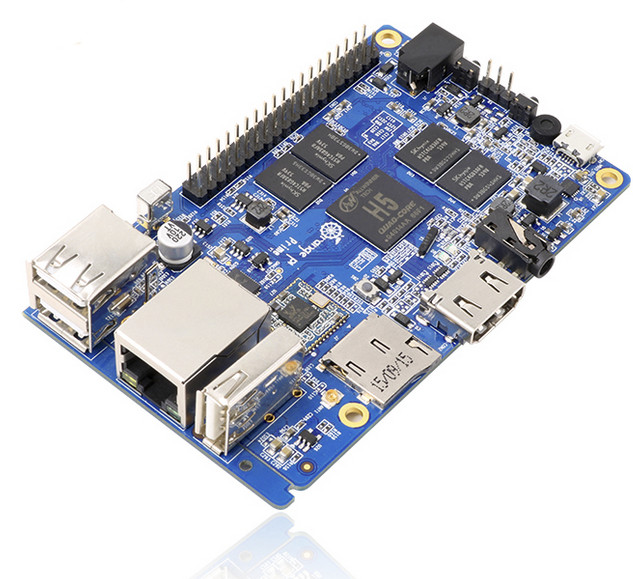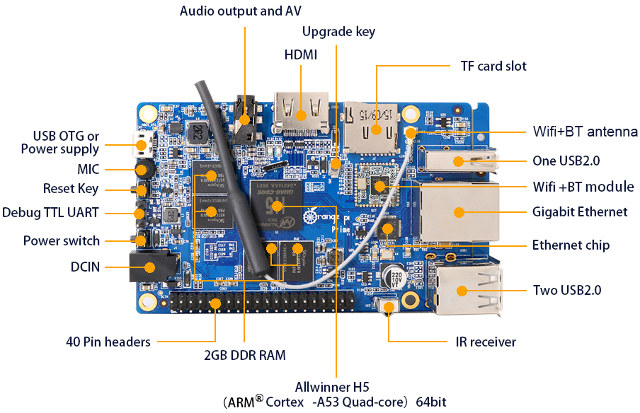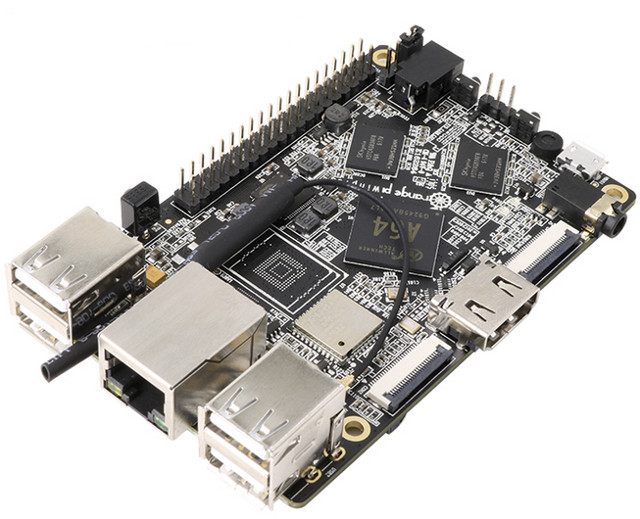Shenzhen Xunlong has already been selling 64-bit ARM development board with their Orange Pi PC 2 & Orange Pi Zero Plus 2 H5 boards based on Allwinner H5, as well as Orange Pi Win board powered by Allwinner A64 processor. However, so far none of them are equipped with much memory, with the only options being 512MB or 1GB RAM. The company has recently launched two new boards with 2GB RAM, namely Orange Pi Win Plus featuring Allwinner A64 SoC, and Orange Pi Prime equipped with Allwinner H5 SoC.
Orange Pi Win Plus
That board is just an update to Orange Pi Win board with the only difference I could find being the 2GB RAM:
- SoC – Allwinner A64 quad core ARM Cortex A53 processor @ 1.2 GHz with Mali-400MP2 GPU
- System Memory – 2GB DDR3
- Storage – 2MB SPI flash, micro SD slot up to 64GB, footprint for optional eMMC flash
- Video Output / Display interface – HDMI 1.4 up to 4K @ 30 Hz with CEC, 3D and HDCP; MIPI LCD interface
- Audio – HDMI, 3.5 mm headphone jack, built-in microphone
- Connectivity – Gigabit Ethernet + 802.11 b/g/n WiFi & Bluetooth 4.2 (AP6212)
- USB – 4x USB 2.0 host ports, 1x micro USB OTG port
- Camera – MIPI CSI interface up to 5MP camera, up to 1080p@30 fps video capture
- Expansion – 40-pin Raspberry Pi somewhat-compatible header
- Debugging – 3-pin UART header
- Misc – IR receiver; reset and power buttons; power and status LEDs;
- Power
- 5V via power barrel or micro USB port
- Lithium battery header
- Power selection jumper (4-pin header)
- AXP803 PMIC
- Dimensions – 93 x 60 mm
- Weight – 48 grams
The company has released Android, Ubuntu 16.04 “Xenial” Server & Desktop, and Debian Jessie Server & Desktop images for the board on the resources page. Windows 10 IoT support is coming later thanks to a partnership between Allwinner and Microsoft. It’s also possible community images will also become available.
Orange Pi Prime
 Orange Pi Prime required a new PCB layout, but it still shares many of the features found in Orange Pi PC 2 (changes highlighted in bold):
Orange Pi Prime required a new PCB layout, but it still shares many of the features found in Orange Pi PC 2 (changes highlighted in bold):
- SoC – Allwinner H5 quad core Cortex A53 processor with an ARM Mali-450MP4 GPU
- System Memory – 2GB DDR3
- Storage – micro SD card slot up to 64GB, optional 8Mbit SPI NOR flash
- Video Output – HDMI 1.4 with CEC support, AV port
- Audio I/O – HDMI, AV port, on-board microphone
- Connectivity – Gigabit Ethernet, 802.11 b/g/n WiFi + Bluetooth 4.0 with u.FL antenna
- USB – 3x USB 2.0 host ports, 1x micro USB OTG port
- Camera – MIPI CSI Interface for up to 5 MP camera sensor
- Expansions – 40-pin Raspberry Pi compatible header
- Debugging – 3-pin UART header for serial console
- Misc – IR receiver; Power & reset buttons; Power and status LEDs
- Power Supply – 5V/2A via barrel jack or micro USB port
- Dimensions – 98 x 60 mm (Orange Pi PC 2 was 85 x 55 mm)
- Weight – 48 grams (38 grams for Orange Pi PC 2)

Xunlong has released four OS images on their resources page: Android, Ubuntu Desktop, Arch Desktop, and Debian Desktop. Since the board is so similar to Orange Pi PC 2, except for the extra memory, wireless module, and reset button!, and Orange Pi PC 2’s Armbian Ubuntu Xenial server & desktop nightly build images with Linux 4.10 are available, I’d expect an Orange Pi Prime build soonish. Note that while Armbian image with mainline Linux may have improved security and potentially better performance, a few things like GPIOs may not be working yet.
Orange Pi Win Plus is sold on Aliexpress for $29.99 shipping, and Orange Pi Prime for the exact same price.

Jean-Luc started CNX Software in 2010 as a part-time endeavor, before quitting his job as a software engineering manager, and starting to write daily news, and reviews full time later in 2011.
Support CNX Software! Donate via cryptocurrencies, become a Patron on Patreon, or purchase goods on Amazon or Aliexpress





